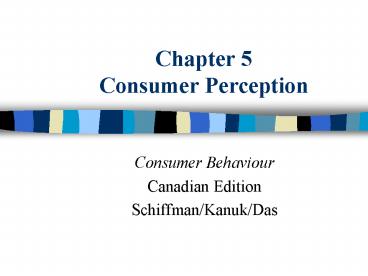Chapter 5 Consumer Perception - PowerPoint PPT Presentation
1 / 24
Title: Chapter 5 Consumer Perception
1
Chapter 5Consumer Perception
- Consumer Behaviour
- Canadian Edition
- Schiffman/Kanuk/Das
2
Perception
3
Perceptual Concepts
Perception is the process by which an individual
selects, organizes, and interprets stimuli into a
meaningful and coherent picture of the world. It
is how we see the world around us.
- Sensation
- Absolute threshold
- Sensory Adaptation
- Differential threshold (jnd)
- Webers law
- Subliminal Perception
Selection
4
Marketing Applications of the JND
- Need to determine the relevant j.n.d. for their
products in order to facilitate change
5
(No Transcript)
6
- As a marketing manager, would you want the
following changes to fall above or below the jnd? - Price increases?
- Size decreases?
- Quality improvements?
- Brand name changes?
7
Subliminal Perception Effective?
- Extensive research has shown no evidence that
subliminal advertising can cause behaviour
changes - 1957 - James Vicary (Eat Popcorn Drink
Coca-Cola) never released study descriptives no
independent evidence - http//www.snopes.com/business/hidden/popcorn.asp
- 1970s - Wilson Bryan Key Sexploitation
- Some evidence that subliminal stimuli may
influence affective reactions
8
Concepts Concerning Selective Perception
- Selective Exposure
- Selective Attention
- Perceptual Defense
- Perceptual Blocking
Which stimuli get selected depends upon
consumers previous experience as it affects
their expectations and their motives at the time
of stimulus exposure.
9
How can marketers overcome blocking?
PANEL EXERCISE 1
10
Principles of Perceptual Organization
- Figure and ground
- Definition of figure depends on the background
- Grouping
- Information is organized into chunks
- Closure
- Incomplete stimuli create tension
Gestalt Psychology
11
Grouping
12
(No Transcript)
13
Closure
14
Closure Continued
15
Perceptual Interpretation
- Stereotypes
- Individuals biased pictures in their minds of
the meaning of various stimuli - Main factors that influence stereotypes are
- Physical Appearances
- Descriptive terms
- First Impressions
- Halo Effect
16
Stereotype
17
Perceptual Interpretation
- Kool-Aid Commercials
What is your perception? How was it
formed? Consider perceptual distortion.
Perceptual distortion is the lack of
correspondence between the way a stimulus is
commonly perceived and the way an individual
perceives it under given conditions.
18
Consumer Imagery
- Product Positioning and Repositioning
- Perceived Price
- Satisfaction based, relationship and efficiency
pricing - Perceived Quality
- Reliance on extrinsic cues SERVQUAL
- Price-Quality Relationship
- Image
- Store and manufacturer
- Perceived Risk
19
(continued)
20
Figure 5-9 (continued)
21
Positioning
- Establishing a specific image for a brand in
relation to competing brands - Frequently analyzed using perceptual maps
- Positioning Techniques
- Umbrella Positioning
- Positioning Against Competition
- Positioning Based on a Specific Benefit
- Taking an Unowned Position
- Positioning for Several Positions
- Repositioning
22
Perceived Risk
- The degree of uncertainty perceived by the
- consumer as to the consequences
(outcomes) of a specific purchase decision - High-risk perceivers ? narrow categorizers
- Low-risk perceivers ? broad categorizers
Types of Risk Functional Psychological Physical F
inancial Social Time Loss
23
How Consumers Handle Risk
- Seek Information
- Stay Brand Loyal
- Select by Brand Image
- Rely on Store Image
- Buy the Most Expensive Model
- Seek Reassurance
24
Perception and Marketing Strategy
- Make perceptual selection work in your favour
- Increase accidental exposure
- Use the j.n.d
- Draw attention to your ad using contrast and
other principles - Find creative ways to reduce blocking
- Ensure that consumers organize and interpret
messages correctly - Develop suitable consumer imagery
- Find ways to reduce perceived risk































